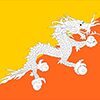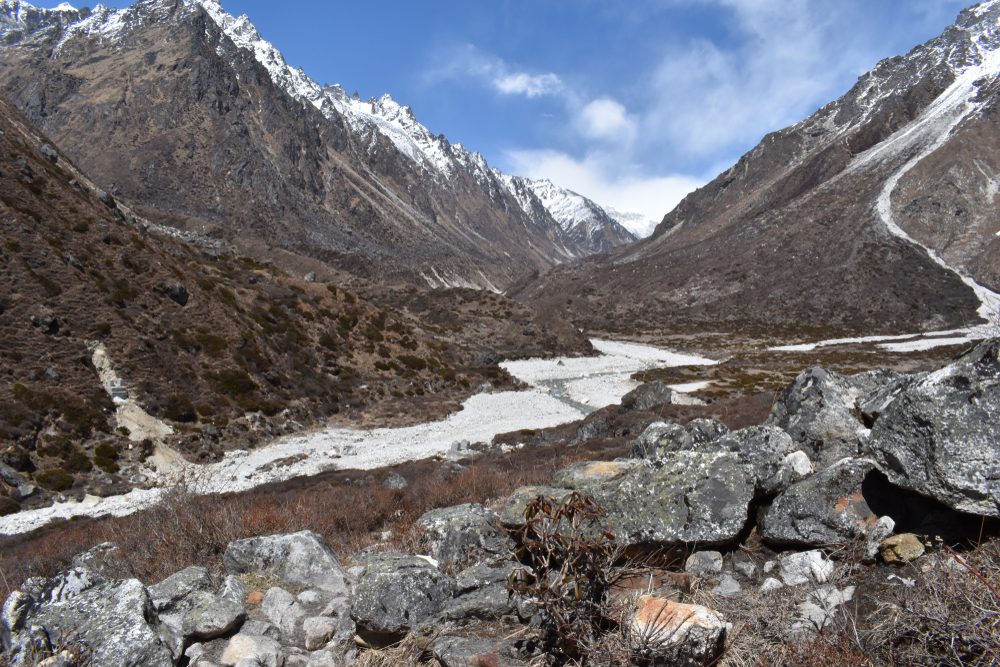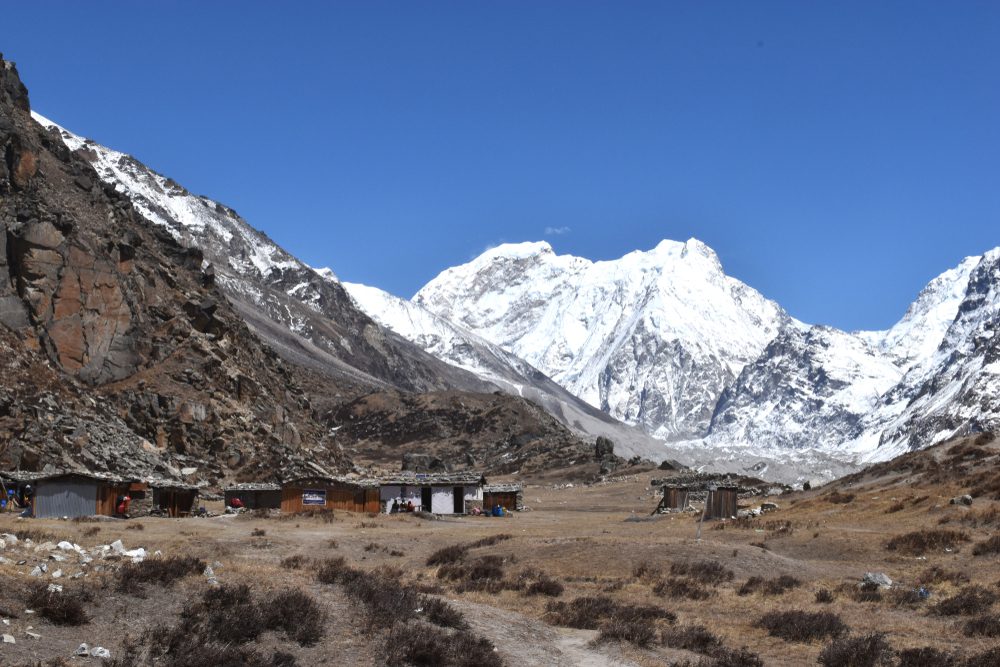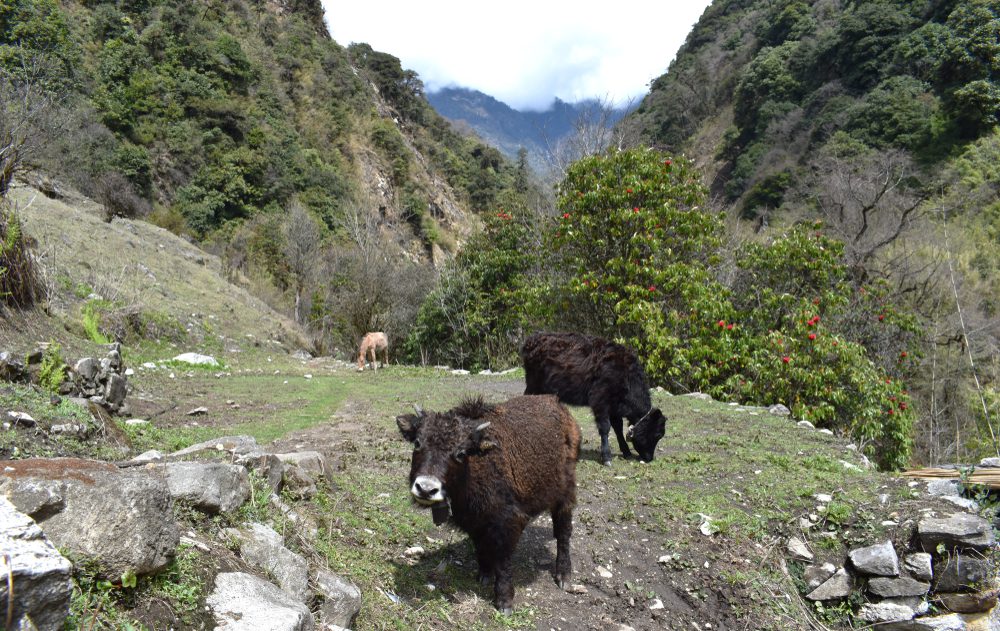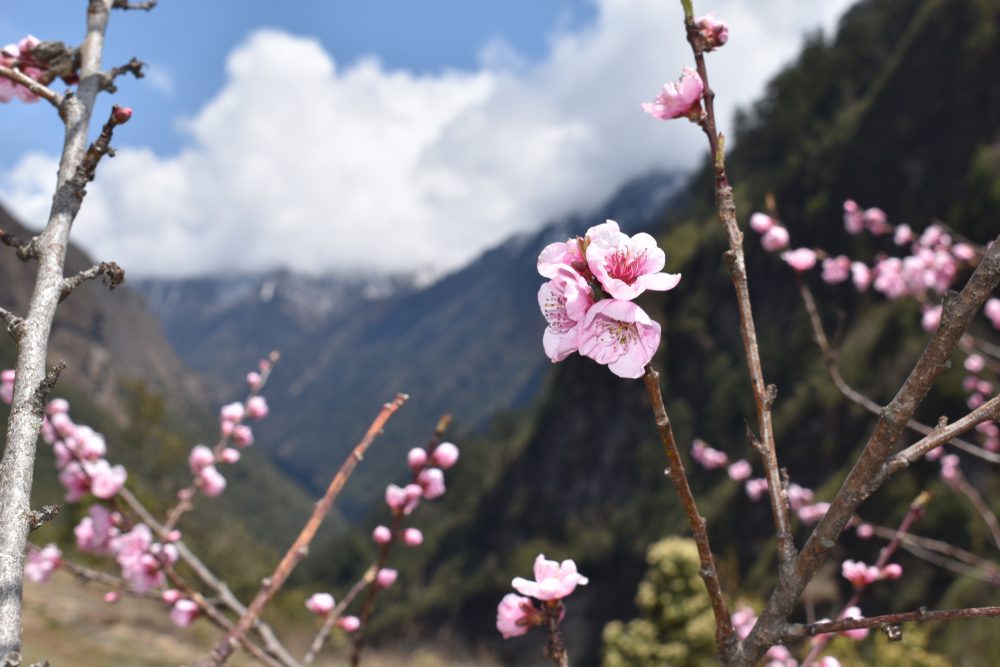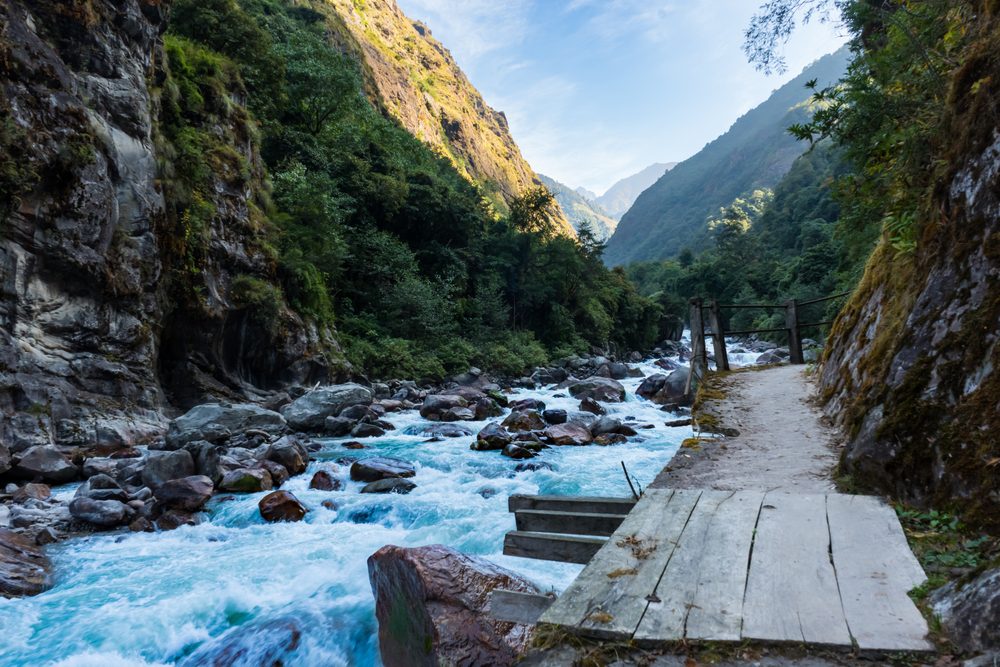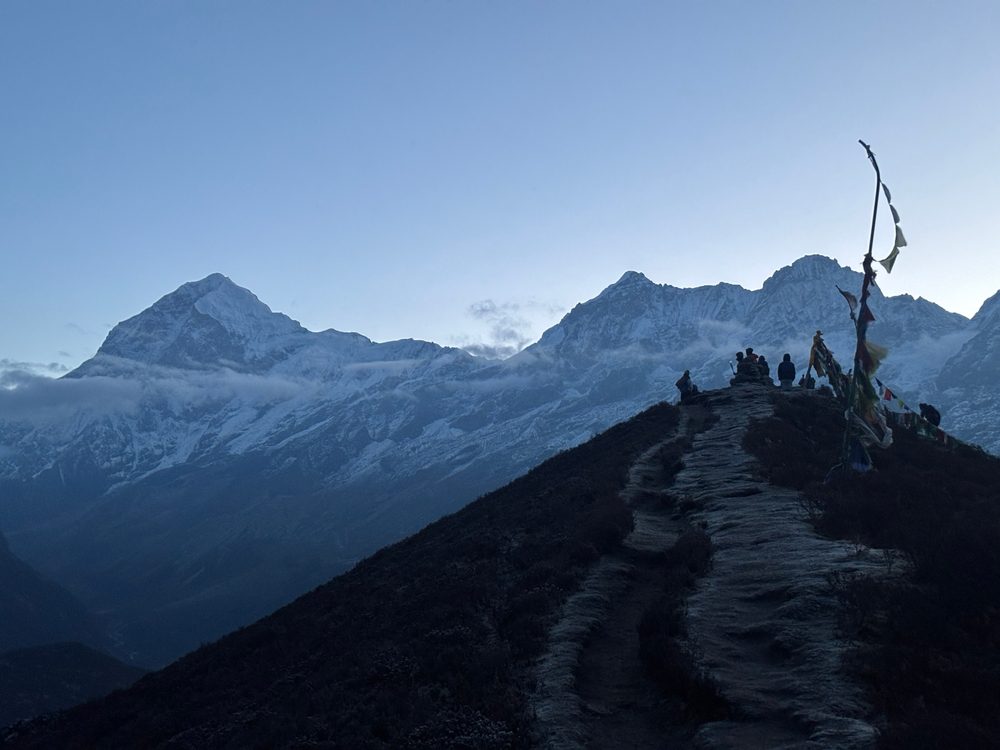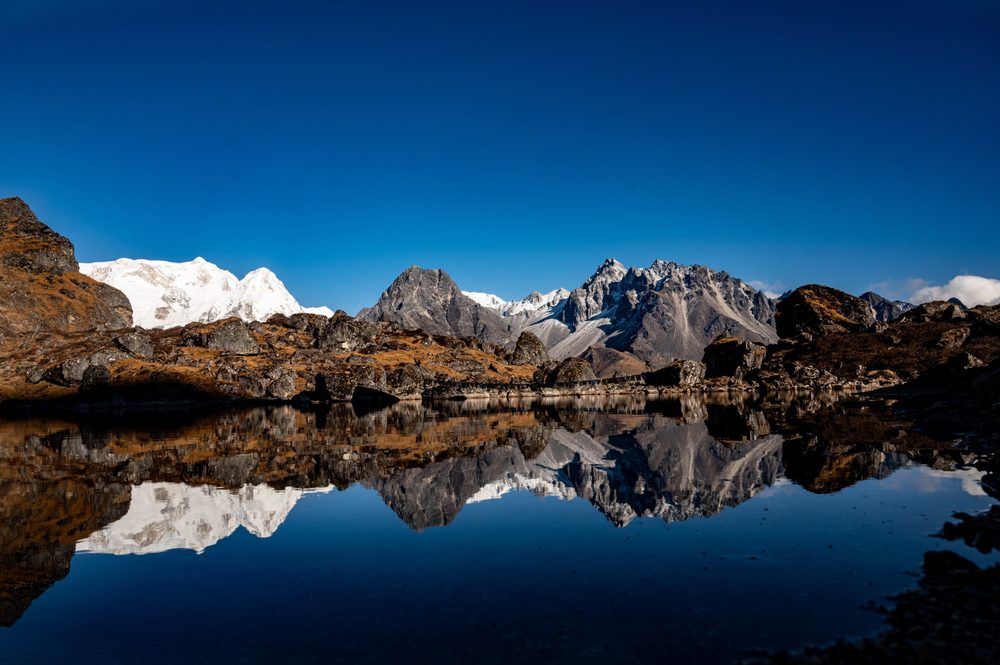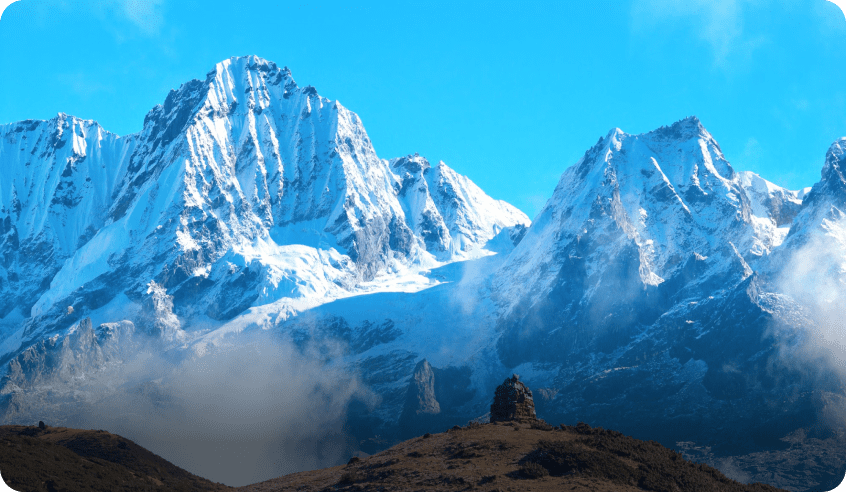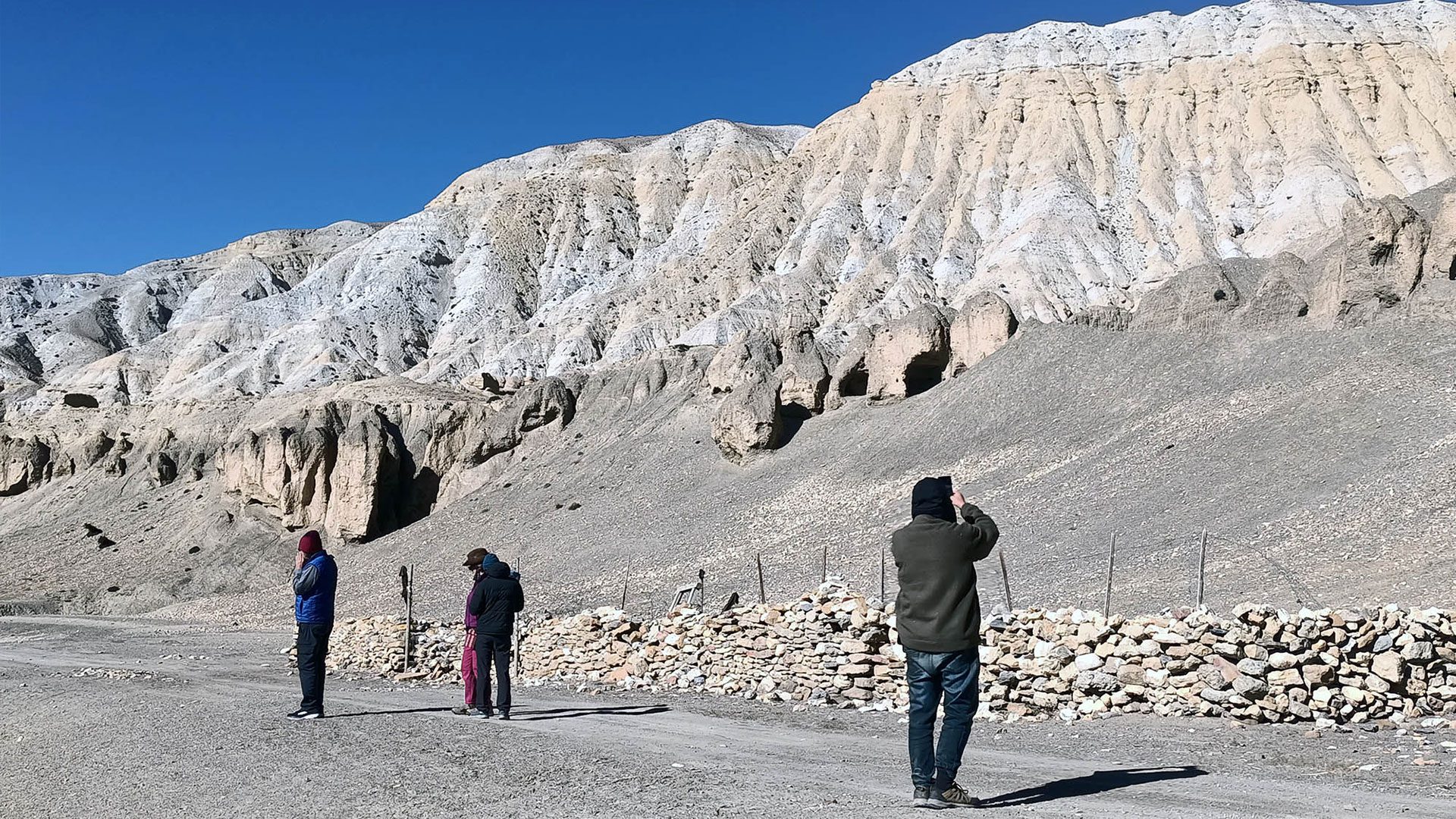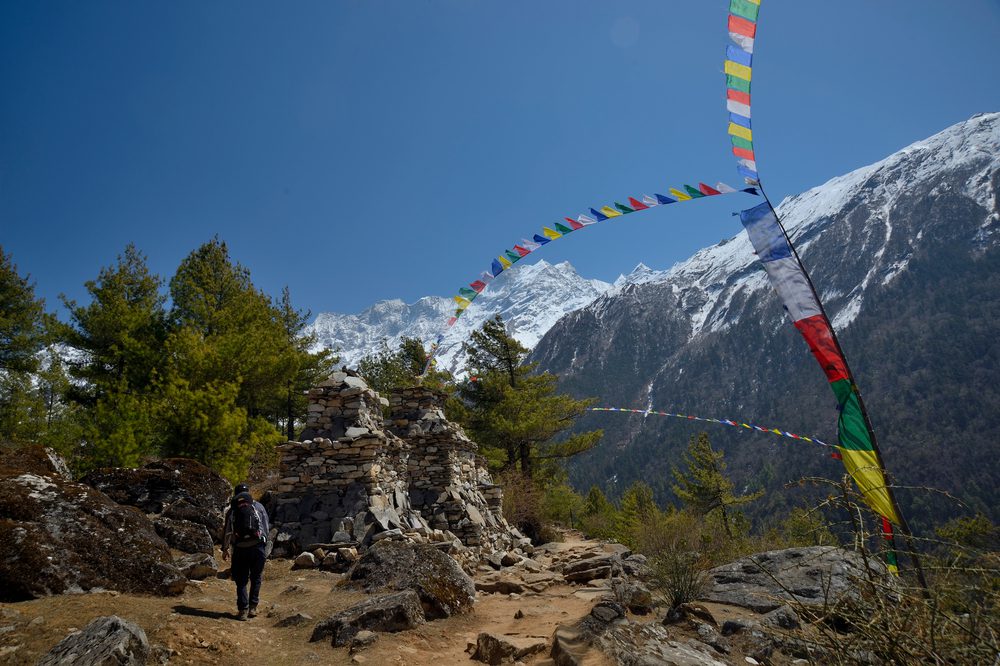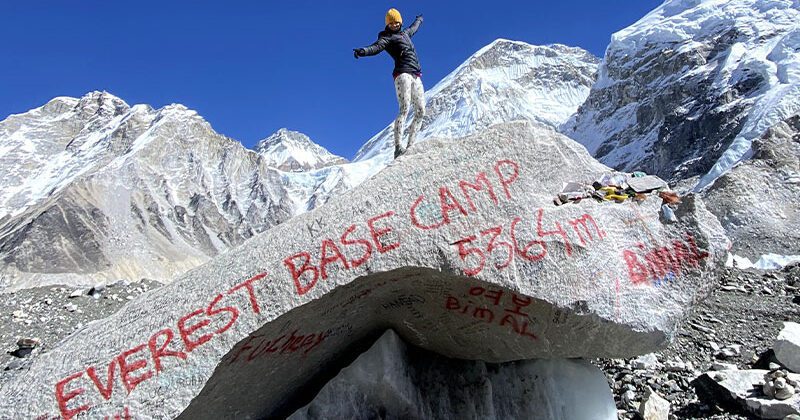Kanchenjunga Circuit Trek 19 days
5(33)
Trip Facts
Overview
Kanchenjunga Circuit Trek (19 days) is the most stunning and challenging trek in Nepal. This trek offers an unforgettable adventure around the Pangpema Base Camp located at 5,143 meters (16,870 feet). Trekkers, who are looking for peace, scenic views, and a closer bond with the Himalayas, this is the best trek for them. This trek is less crowded than the more famous Everest and Annapurna circuit trek, which offer a more peaceful, unique, and interesting experience.
The journey to the Kanchenjunga Circuit trek starts as you land at Tribhuvan International Airport in Kathmandu. You can also explore the valleys of Kathmandu and get to experience the cultural heritage site, the lifestyle of local people residing there, and the artistic crafts in temples and monasteries. After spending the night in Kathmandu you will take the flight from Kathmandu to Bhadrapur early in the morning which can be reached in 45-50 minutes. The scenic drive to Taplejung will capture the hearts of many trekkers. Your trek starts from Sekathum to Amjilosa. As you go ahead you will trek to other high-altitude places such as Ghunsa, Khambachen. On the ninth day, you will acclimate your body for the high altitude trek i.e. Kanchenjunga North base camp (Pangpema Base Camp) located at around 5,143 meters (16,874 feet). It is a crucial part of the trek. To avoid the risk of altitude sickness, you must take proper rest and precautions. This trek offers incredible views of the mountain peaks (Jannu, Kumbhakarna, and Panchchuli), and glaciers and gets to know the local culture of the Bhotia village. You can capture the most memorable and breathtaking views you ever seen in your life. Then you will descend to the villages such as Tseram, Tortong, Yamphudin, and Kanyam. By collecting all the adventurous, and memorable moments, you can return to Bhadrapur. From there you can take a late afternoon flight to Kathmandu.
This 19-day journey ensures you provide the breathtaking, adventurous, thriller, and peaceful vibe you are seeking. Not only do you get to experience the adventure and thrills, but you also get to experience the real natural beauty, culture, lifestyle, and tradition of the Kanchenjunga region. Trekking is a path for your personal growth that pushes you to further your capabilities. It is a journey not only physical activity but also a mental and emotional journey. Be ready to push your limits further, enjoy every second of this amazing trek, and depart with the best feeling you’ve ever felt. So, let’s begin!
Kanchenjunga Circuit Trek Highlight
- Mount Kanchenjunga, is located at 8,586 meters (28,169 feet) above sea level from where incredible mountain views can be enjoyed.
- Breathtaking landscapes with vast views of the Himalayas at high altitude passes like Sele La Pass (4,290 meters) and Kang La Pass (5,100 meters).
- Enjoy the Kanchenjunga Glacier and the Ramche Glacier along the trek which is considered as one of the most stunning scenery.
- Witness the beautiful sunrise and sunset views over the Himalayas from Ghumsa and Pangpema.
- Experience other major peaks along the trek, including Makalu (8,485 meters), Lhotse (8,516 meters), Mount Everest, and Kanchenjunga’s satellite peaks.
- Enjoy the natural beauty of high-altitude lakes, such as Ongden Lake, which is sacred to the locals.
- Kanchenjunga Base Camp is considered one of the most remote base camps in Nepal from where the platonic views of surrounding peaks, and Kanchenjunga Glacier can be enjoyed.
- Witness the immersive cultural experience of villages like Selele, and Birtamod and traditional Limbu, Rai, and Sherpa villages.
- Experience The Tibetan Buddhist culture in the Buddhist monasteries and chortens giving the trek a spiritual dimension.
- Witness the rare and unique wildlife such as the red panda, Himalayan black bear, snow leopard, wild boar, and various birds like the Himalayan monal (the national bird of Nepal) can be spotted along the trail.
- Pangpema Base Camp, which is located on the south side of Mount Kanchenjunga, at an altitude of around 5,143 meters (16,870 feet) provides breathtaking views of Kanchenjunga’s northern face, the Kanchenjunga Glacier, and towering peaks such as Jannu and Panchachuli.
Itinerary
Your Journey, Step by Step
Trek Permit Preparation Day (Sightseeing tour Optional) (1400m.|4593ft.)
On this day, you will arrange the trekking permits through your trekking agency or Nepal Tourism Board. After finalizing your all trek preparations(packing, paperwork), you can rest for today. If you have enough energy, It will be also a great opportunity for you to explore Kathmandu city. It offers many fascinating historical, religious, and architectural landmarks. Pashupatinath Temple, Boudhanath Stupa, Kathmandu Durbar Square, and, Swayambhunath (Monkey Temple) are some famous places for sightseeing in Kathmandu. You get to experience the lifestyle of local people, their cultures, traditions, and beliefs which is quite amusing to see. After ending the sightseeing tour, you can return to the hotel. Get proper sleep and be ready for the amazing journey ahead!
Stay overnight in Kathmandu.
Morning flight of 45 - 50 minutes to Bhadrapur, then drive to Taplejung (1820m.|5971ft., 7-9 hrs drive, 152 km.)
You will begin your journey toward the Kanchenjunga Circuit Trek on this day. You can take the morning flight to Bhadrapur which takes 45-50 minutes from Kathmandu. The flight offers breathtaking views of the Himalayan mountain range, including distant peaks. After landing in Bhadrapur, you can continue the scenic drive to Taplejung. The roads can be quite bumpy but still enjoyable as you get to experience the rural Nepal, and Himalayas with lush greenery, rivers, and small villages along the way. Then after the 7-9 hours of drive, you will reach Taplejung, which is a small base town.
Stay overnight in Taplejung.
Taplejung to Sekathum (1650m.|5413ft., 39km.|24.23miles., 6 - 9 hrs drive)
Your morning will start with a delicious breakfast in Taplejung. Then you will depart for the Sekathum. This day includes a lengthy drive through eastern Nepal’s rocky highways, which provide stunning views of the country’s agricultural landscapes, rivers, and remote villages. You will cross the suspension bridges along the way. As you go ahead, you will ascend to the dense forest and get a magnificent view of the Kanchenjunga Range. After a 6-9-hour drive, you will finally reach Sekathum, which is a small village that lies along the Ghunsa River.
Stay overnight in Sekathum.
Sekathum to Amjilosa (2498m.|8195ft., 9km.|5.59miles., 5 - 6 hrs trek)
After enjoying breakfast in Sekathum, you will trek to Amjilosa. As you go ahead, you will slowly ascend dense rhododendron forests following the Ghunsa River. After some time you’ll pass through small villages and farm terraces, where locals grow crops like maize, rice, and potatoes, and experience the remote life of people. As you ascend you might get to see wildlife such as Musk Deer, Red Panda, or Himalayan Black Bear on the way. You will feel the slowing rising of altitudes so make sure to avoid the risk of altitude sickness. Then after some trek, you will arrive at Amjilosa offering the most stunning views of the mountain. You can stay in teahouses and rest for the following trek day.
Stay overnight in Amjilosa.
Amjilosa to Gyabla (2725m.|8940ft., 8km.|4.97miles, 4 - 5 hrs trek)
You will start your trek to Gyabla after having some breakfast. Today, you will slowly ascend to the deeper forests of oak, rhododendrons, and pine trees. As you go ahead, you will pass through small villages like Khebang. This trek offers you a peaceful environment as you go further. The breathtaking views of Kanchenjunga Range and snow mountains make your trek even more exciting. Then, finally, you will arrive at the small Tamang village, Gyabla. The village itself is a peaceful retreat for trekkers. You can rest and enjoy the calm environment.
Stay overnight in Gyabla.
Gyabla to Ghunsa (3415m.|11204ft., 11km.|6.83miles., 5 hrs trek)
You will start your trek with a solid breakfast in Gyabla. As you ascend ahead, you will go through the lush forest of rhododendrons and bamboo. The trek crosses streams and small suspension bridges as you ascend towards Ghunsa. You’ll also see Buddhist prayer flags, mani stones, and chortens that represent the local culture and spirituality along the route. Then after 5 hours of trek, you will reach Ghunsa village, home of many Sherpa people, where you will be able to see the fancy mountains. You can visit the Buddhist monastery.
Stay overnight in Ghunsa.
Ghunsa to Khambachen (4145m.|13599ft., 11km.|6.83miles., 5 - 6 hrs trek)
You will set off on your trip from Ghunsa early in the morning. Along the route, you may enjoy the peaceful setting of the bamboo forest and some dense forest regions, which include a slow altitude. You will begin to see more pastoral areas and alpine meadows as you ascend. As you get closer to the Khambachen district, the ascent gets steeper. You might travel across some glacial mountains and the landscape might become more rocky. You’ll also see more Buddhist symbols such as mani walls and prayer flags. After your arrival at Khambachen, you can take a rest and stroll around the village for the stunning views of mountain peaks, with views of Kanchenjunga and other surrounding ranges.
Stay overnight in Khambachen.
Acclimatization and Rest Day
On this day, you will rest and acclimate at Khambachen (4145m / 13,599ft.). It is an important part of the trek because you need to adjust your body to the upcoming high-altitude hikes. You can stroll around the village if you want to. You will get to explore the community and discover more about the people’s ways of life and Tibetan Buddhist culture. You may find traditional Tibetan prayer flags, monasteries, and stone stupas in the region. Khambachen is surrounded by towering peaks of the Kanchenjunga range, with spectacular views of Jannu Peak (7,710m) and Kanchenjunga itself. The village is set against a backdrop of majestic snow-capped mountains and glaciers, making it a scenic and serene place to rest. You will get to experience incredible panoramic vistas of towering mountains, glaciers like Kanchenjunga glacier, and alpine meadows.
Although it’s a rest day, keeping active is important. Stay hydrated, eat well, take proper precautions, and prepare for the challenging trek ahead. Rest well and enjoy the peaceful unique culture and hospitality of the local communities.
Stay overnight in Khambachen.
Khambachen to Lhonak (4792m.|15721ft., 10 km.|6.21miles., 4 - 5 hrs trek)
On this day, you will be trekking from Khambachen to Lhonak. It is an exciting day that takes you higher into the Kanchenjunga region. As you ascend high level, the landscapes become more rugged and wide, providing some of the most breathtaking mountain vistas. Then you continue to trek into alpine meadows and more rocky terrain. You’ll start to notice small glacial rivers flowing from the surrounding glaciers and beautiful snow-capped peaks including Kanchenjunga South, Kanchenjunga Main, and Jannu. After 4-5 hours of trek, you’ll arrive at Lhonak, which is a high-altitude remote village located at 4792 meters (15,721 feet). You can enjoy the beautiful rugged landscapes, peaks, and glaciers.
Stay overnight in Lhonak.
Hike to Kanchenjunga North base camp (Pang Pema) (5143m.|16873ft.) and return to Lhonak (9km.| 5.59 miles., 6 - 7 hrs trek)
This day of trek is the most challenging and thrilling day of your Kanchanjunga Circuit trek. An early start will guarantee you have enough daylight and stamina to finish the trek because it’s a long and demanding day. As you ascend further, you will pass through the glacial rivers. The trail is rocky and rugged and there is slowly the increase of altitude so make sure to pace yourself and take breaks as needed. On the way, you’ll get to see the spectacular views of Kanchenjunga, especially the North Face of the mountain and the glaciers such as the Lhonak Glacier. After 3 to 4 hours, you’ll arrive at Pang Pema, which is the North Base Camp of Kanchenjunga. This is the highest point of the trek. You’ll be surrounded by impressive mountain views, including close-up vistas of Kanchenjunga, Jannu, and other peaks. Enjoy your accomplishment to the fullest, you can capture the photos of the stunning vistas around you.
After some time, you can return to Lhonak. Descend slowly and take breaks if needed. Once you return, give your body rest, eat well, and spend the night in the teahouses available there.
Stay overnight in Lhonak.
Lhonak to Ghunsa (3415m.|11204ft., 21km.|13miles., 7-8 hrs trek)
Your trek starts early in the morning after you have some breakfast in Lhonak as this is a long day of trekking. As you descend, you’ll pass rocky terrain, glacial moraines, and high-altitude meadows. It will be easier to trek as the altitude drops significantly. As you go ahead, the landscapes will start to change, offering beautiful views of the valleys, forests, and rivers. You will pass through rhododendron trees and pine forests making you dazed in the beauty. The trail will take you through beautiful valleys and river crossings. You may pass several streams, the glaciers and waterfalls, making for a scenic and peaceful environment. After some times, you will slowly enter the dense forest and sense the presence of mani stones and prayer flags as you approach. Then after 7-8 hours of trek, you will finally reach in Ghunsa. Settle in teahouses, and take rest. You can stroll around the village if you have energy to do so.
Stay overnight in Ghunsa.
Trek to Sele Le Base Camp (4240m.|13910ft., 6km.| 3.72 miles., 5-6 hrs trek
Start your trek early in the morning after having breakfast in teahouse. This will be a moderate day of trekking. As you descend to Sele Le Base Camp, you will pass through forests of pine and rhododendron and you can see the wildlife such as yaks, marmots, and mountain goats. The landscape will change from lush forests to mountain fields. As you go ahead, The route gets more open and rocky. You will get to see the incredible views of the surrounding Kanchenjunga massif, including Kanchenjunga, which is the third highest mountain in the world. After some hours of trek, you will reach Sele Le Base Camp, situated at an altitude of 4240 meters (13,910 feet), which is isolated and peaceful spot to relax and end a day of trek. The night view from Sele Le Base camp is breathtaking as the stars shine brightly in the sky, offering a peaceful sight.
Stay overnight in Sele Le Base Camp.
Trek from Tseram to Ramche and Hike to Oktang (Yalung South Base Camp Viewpoint, 4740m.|15551ft.) and back to Tseram (14km.|8.6km) 7-8 hrs trek)
Start your trek with a morning breakfast in Tseram. Then you will ascend towards Ramche. The terrain is quite rocky including alpine meadows, and glacial moraines. As you go ahead, you’ll enjoy breathtaking views of Kanchenjunga and the Yalung Glacier. After going further, you will see the breathtaking Kanchenjunga Range and other nearby peaks like Jannu and Kangbachen. It offers stunning photographic opportunities. After some time, you will reach Ramche, which is a key stop for trekkers. You can rest and eat snacks as you go for another challenging trek to Oktang.
After resting properly, you can continue your trek to Oktang. As you ascend, the trail becomes more rocky passing through barren alpine terrain and glacial landscapes. On the way, you will also pass through the glacial valley with magnificent views of the surrounding snow-capped peaks, including Kanchenjunga. After 2-3 hours of trekking, you will reach Oktang, which is also called the Yalung South Base Camp Viewpoint situated at 4,740 meters (15,551 feet). You’ll get to experience the magnificent views of Kanchenjunga’s south face which includes spectacular views of Jannu, Kangbachen, and other peaks. It is a perfect spot for photography. Then you can descend back to Tseram and take rest in the available teahouse.
Stay overnight in Tseram.
Trek from Tseram to Tortong (2980m.|9776ft., 13km.| 8 miles., 6-7 hrs trek)
You will begin your trek to Tortong after breakfast. As you descend, you will pass through alpine meadows and forests of rhododendron and oak. As you go ahead, the landscape will gradually become more lush and green. After crossing the suspension bridge, you will slowly descend through the dense rhododendron forests and pass through several waterfalls and streams. After 6-7 hours of trekking, you will arrive in Tortong, which is a lovely village known as the resting point for trekkers heading down from the higher altitudes of the Kanchenjunga trek. You can enjoy the peaceful surroundings and take time to relax.
Stay overnight in Tortong.
Trek from Tortong to Yamphudin (1692m.|3910ft., 9km.|5.59ft., 6-7 hrs trek)
On this day, you will be trekking to Yamphudin. You will start your trek by having breakfast in Tortong. As you descend, the environment becomes increasingly green and humid, with dense forest areas, rivers, and waterfalls. On the way, the terrain gradually changes to subtropical forests after passing through lovely rhododendrons and mixed woodlands. Wildlife like birds, monkeys, and other creatures native to the lower mountain forests may also be visible to you. You will continue to descend through farmlands and little communities. In the lowland villages, where people live more in tune with nature and engage in agriculture, you’ll get a taste of local life. After some hours, you arrive in Yamphudin, which is a small village located at the edge of the lowland hills. It is the last stop for trekkers. You can get amazing views of farmland, forests, and mountain views and get a chance to witness some aspects of the Limbu people’s culture. Stroll around the village if you want to and experience the local lifestyle of people residing there.
Stay overnight in Yamphudin.
Yamphudin to Kanyam (1210m.|3969ft., 8 hrs drive)
Start your drive to Kanyam after having a hearty breakfast in Yamphudin. This is a long drive, so enjoy the scenic and beautiful views on the way. The drive winds through steep, rugged terrain. The first few hours of the drive will be on winding mountain roads, with breathtaking views of lush greenery, flowing waterfalls, and glimpses of the valleys below. As you descend, the roads may be narrow and rough, but you’ll be passing through small villages, dense forests, and gorgeous river valleys. The drive can be bumpy, so be prepared for a long ride with some parts that might take longer due to road conditions. The terrain will start to change from thick forests to more exposed landscapes. You will start to see the green hills, and the mountainous landscape gradually, which gives way to more subtropical areas, tea plantations. You will pass by various small villages which show this region of Nepal.
After hours of drive, you will finally reach Kanyam, which is a village located at a lower altitude in the Ilam District. You will get to see tea gardens and picturesque landscapes and enjoy a peaceful time there.
Stay overnight in Kanyam.
Drive from Kanyam to Bhadrapur and late afternoon flight back to Kathmandu (1400m.|4593ft.)
This is the last day of your trekking in the Kanchenjunga Circuit trek. After the peaceful night in Kanyam, you will now board to Bhadrapur which takes 3-4 hours of drive. The drive will provide you with scenic views of rural villages and lush landscapes giving you a cool and refreshing vibe. You will pass through the subtropical environment, with lush greenery, tea estates, and agriculture. Then you will arrive in Bhadrapur. You can take a quick stroll and grab some food there. Then be ready for your afternoon flight back to Kathmandu. This will be a short flight which takes 45 minutes. You can enjoy the incredible views of the eastern Himalayas the Nepalese landscape and some mountain ranges. After your arrival in Kathmandu, you will be whisked to your hotel. You can take a rest after.
Kathmandu is a beautiful city in Nepal. You can stroll around the city if you are not tired. You will get to explore the various cultural sites and experience the Nepalese cultures. This will be a great memory for you to come with lots of stories of adventure and exciting trek. You can also try our Half-Day Bhaktapur Durbar Square Tour if you have some time to spare and love cultural heritages.
You can take a morning flight to your country. Even after your departure, this trek will be a great experience for you. Have a great flight!
Customize this trip with help from our local travel specialist that matches your Interests.
Customize This TripInclusions
What’s Covered in Your Adventure
- Airport Pickup and drop service during both international and domestic flights
- All necessary trekking permits during the trek
- Kanchanjanaga restricted permit
- Hotel in Kathmandu for 2 nights
- All accommodations during the trek
- Meals (Breakfast/Lunch/Dinner)
- Government-licensed and first-aid-trained trekking guide salary, food, equipment, and insurance of the trekking Guide
- Sharing Jeep / Bus (Bhadrapur - Taplejung - Sukethum and Phidim - Kanyam - Bhadrapur airport)
- Flight from Kathmandu - Bhadrapur and Bhadrapur - Kathmandu or suketar / return
- First aid kit with basic medication
- Sleeping bag / Down Jacket if needed (available for rent)
- Adventure master cap, Trekking Map, and Water purification tablet
- Official expenses, all local and government taxes, and VAT.
- International flight tickets and Nepal entry visa
- Travel and Health Insurance that covers emergency Rescues and evacuations
- During trekking time, personal expenses, snacks, beer, coke, juice, water, WI-FI, etc.
- Porter ($400 One porter between two trekkers)
- Private Jeep ($ 600 - Bhadrapur - Taplejung - Sekathum and Yamphudin - Kanyam - Bhadrapur airport)
- Lunch and Dinner in Kathmandu
- Tips for trek guides (it is expected)
Maps
Navigate Your Journey
Good to Know
Your Journey, Step by Step
Accommodation and Acclimatization on Kanchenjunga Circuit Trek
The majority of the lodging options on the Kanchenjunga Circuit are tea houses with simple bedding, rooms, and communal amenities. Accommodations at higher elevations are more basic and offer fewer conveniences. Teahouses provide basic rooms with a twin bed, a mattress, a blanket, and a pillow. They are generally affordable but as you hike to higher altitudes the price can be expensive. At higher altitudes, the rooms are more rustic, with less comfort, but they offer protection from the elements. It is highly recommended to bring your own sleeping bag for extra warmth, as temperatures can drop significantly, especially at night.
The important part of the trek is acclimatization. Before you reach higher altitudes like Pangpema Base Camp, you need to adjust and train your body for the upcoming challenge. Resting at a lower altitude will give your body time to recover. You can acclimate in Khambachen which is a popular stop to make during the trek. It is a great opportunity to enjoy the alpine scenery, towering peaks, glaciers, rocky landscapes, and stunning views of the Kanchenjunga Range. To avoid the risk of altitude sickness, you have to take proper rest before ascending to a higher altitude place. It is most important to take care of your body rather than the trek. So, by following proper precautions and resting well, you can enjoy a safer and more adventurous trek.
Food and Drinking Water in Kanchenjunga Trek
Food and drinking water in the Kanchenjunga Circuit trek can be more basic and limited as it lies in a remote location. The tea houses that are available along the routes provide you with basic local and Western food which are still filling. Dal bhat, momos, noodles, pasta, pizzas, sandwiches, French fries, noodle soup, rice porridge, and Tibetan bread are some of the basic foods available there. You can also get snacks like chocolates, nuts, and energy bars in the tea houses. As you ascend to higher altitudes like Lhonak, and Ghunsa, you can charged more for the basic food.
Hydrating yourself is the most crucial part of the trek. Along the route, you can get many water sources like rivers, and streams but they might not be clean enough to drink. So you can use water purifications like tablets, a UV sterilizer (Steripen), and boiling water. The teahouses buy bottled water but it can be pricy. So it is recommended to boil the water in teahouses by paying a small amount of money. For the long trek, you have to hydrate yourself properly by drinking 3-4 liters of water per day.
Altitude sickness in Kanchenjunga Circuit Trek
There is a high chance of altitude sickness while trekking to the Kanchenjunga Circuit Trek but it is also avoidable if you take proper precautions and acclimatization before ascending to the higher altitude places. Altitude sickness causes various symptoms such as headache, nausea or vomiting, dizziness or lightheadedness, fatigue, loss of appetite, and difficulty in sleeping. If you experience any symptoms, descend quickly and settle until you are fully recovered. You must prioritize your health over anything else. Always stay hydrated, eat enough food, acclimate, and adjust your body enough to hike to higher altitudes. Then you can continue your trek peacefully without any difficulties.
Difficulty in Trek
The trek to Kanchenjunga Circuit is rewarding but it can be also quite difficult due to its remote location, rugged terrain, and high-altitude challenges. It requires a lot of physical strength, patience, and a proper guide and porter for you to carry out this trek. The trek also includes several long, difficult days with significant altitude gains. It may be challenging if any unpredictable weather occurs like rain, storms, etc. The trails along the route are narrow and can be blocked by rocks and due to rugged terrain, it can be hard to walk. You must take an experienced guide who knows the trails very well to avoid any uncertain difficulties. If you take full precautions and make planning before starting the trek, then you can enjoy the stunning beauty of one of the most majestic mountain regions in the world.
Bhadrapur Flight and Weight Limit
Bhadrapur is situated near the Indian border in the Jhapa District in the southeast of Nepal. It grants entrance to the Kanchenjunga region and serves as the entry point to Nepal’s eastern region. You can take a flight from Kathmandu to Bhadrapur which takes 45 – 50 minutes. Flights to Bhadrapur are usually available in the morning to avoid afternoon weather disruptions. Yeti Airlines, Buddha Air, and Sita Air offer flights to Bhadrapur.
Domestic flights have strict weight limits due to the small aircraft set up on these routes. You should carry 20 kg per person or more than that. You may have to pay an extra fee if your baggage weighs more than that. The carry-on baggage limit is usually 5 kg per person. You can put your essential items such as your passport, camera, valuables, and any necessary medications. If you have luggage, you can pay extra for it.
Note: Flights can be delayed due to the uncertain weather conditions. So it is recommended to plan for your trek in a best season like spring and autumn.
Kanchenjunga Circuit Trek Group Size
The Kanchenjunga Circuit Trek group size can change depending on whether you are hiking alone or in a group organized by a trekking agency. The group size varies from 2 to 20 people. Smaller groups( 2-4 people) are provided with personal care, more flexibility, and easier practical coordination because they are better suited to the demanding environment and remote nature of the hike. The guides can also give personal attention if the group is small. It can be quite challenging to travel with big groups due to the slow progress of the trek, delays, and the crowd. But if you are already planning to trek in a larger group (12-20 people), you will get social experience too. Solo trekking is not allowed for the Kanchenjunga Circuit trek.
Electricity and Internet Service
The Kanchenjunga Circuit Trek has access to electricity and internet service but it can be limited as it is a remote location. In the lower areas of the trek around Suketar, Bhojpur, and Ghunsa, electricity is generally available in teahouses. Solar energy is the primary source of electricity in the Kanchenjunga Circuit trek. You can charge small devices like phones, cameras, and headlamps in teahouses by paying extra money. In higher altitude places like Ramche, and Kanchenjunga Base Camp, electricity may not be available or can be very limited.
You can also find internet connectivity at the lower altitude of the trek. However internet speeds can be slow and unreliable, and sometimes the connection may drop due to weather or network error. Some teahouses provide Wi-Fi services which can be slow and you can do text-based communication. You can bring power banks for charging the phone.
Safety and Security in Nepal and Kanchenjunga Circuit Trek
Nepal is generally considered the safest country for the trek. You can have a great time during the trekking days in Nepal but be sure to go with proper planning and precautions.
The Kanchenjunga trek is the most exciting, achievable, and challenging trek in Nepal. The 19 days to Kanchenjunga trek is really a great time to create a memory with the most beautiful scenes you have ever seen. But you should adopt proper security and safety before setting to the trek.
You may greatly lower the risks involved in the trek by hiking with a guide, keeping up with weather conditions, following acclimatization procedures, and making sure you have the right equipment and insurance. Then you can freely and peacefully enjoy the trek with best adventure and create great memories.
Permits for the Kanchenjunga Circuit Trek
Trek to the Kanchenjunga Circuit trek requires several permits for the safety, conservation, and regulation of tourism. These permits help to protect both the natural environment and local communities while ensuring a controlled and enjoyable trekking experience for the trekkers. The required permits for the trek are listed below:
Kanchenjunga Conservation Area Permit (KCAP): This permit is required for entering the Kanchenjunga Conservation Area, which is a protected region that covers the trekking route.
Restricted Area Permit (RAP) :The Kanchenjunga region lies in a restricted area which is close to the India-Nepal border so this permit is necessary for trekking in the area. The government strictly controls access to this region.
TIMS (Trekkers’ Information Management System) Card : This is a general trekking permit for all trekkers in Nepal, helping authorities track your movements in the mountains.
If you’re in Nepal, you can easily apply for the permits yourself and can look for a trekking agency too. Trekking agencies often assist in securing all the necessary permits.
Required Documents for Permits
- Passwords with validation for at least 6 months
- Valid Nepal tourist visa (can get from Tribhuvan International Airport)
- 2 passport-sized photos for each permit.
- Copy of the permits
- Copy of Travel Insurance (covering high-altitude trekking and evacuation)
Trekking equipment
Equipment is the major thing to consider during a trek. The Kanchenjunga Circuit Trek is remote and challenging so it’s important to have the right trekking gear to ensure both safety and comfort. The weather can be variable, and you’ll be trekking at high altitudes, so your gear should be appropriate for a range of conditions. Here are some of the trekking equipment required for the Kanchenjunga circuit Trek:
General
- Passport: With extra copies and passport-sized photos for permits.
- Trekking Permits: TIMS (Trekker’s Information Management System) card and Annapurna Conservation Area Permit (ACAP).
- Sleeping Bag (at least -15°C (5°F) for cold nights)
- Cash: Nepali rupees for tips, snacks, and small purchases.
- Duffel Bag: Used for your primary luggage, which porters typically carry.
- Backpack: main trekking backpack (for carrying foods and sleeping bags) and day backpack (for short treks with needed essentials like water, camera, extra layers, and snacks)
Upper body
- Sunglasses (with UV protection)
- Sun hats, and woolen hats.
- Scarves/ Buff
Torso
- Base layers
- fleece or down jackets
- insulated jackets
- sweaters
- waterproof outer layers
Lower Body
- Trekking Pants
- Base Layer: Thermal bottoms for added warmth in cold weather.
- Hiking Shorts: For warmer sections of the trek.
- Comfortable Pants: For relaxing in teahouses.
- Waterproof Pants: Shields against rain and snow.
Hands
- Lightweight gloves (for warmth)
- Insulated and waterproof gloves (for colder weather)
Footwears
- Woolen Socks
- Sturdy trekking boots (waterproof, ankle support)
- Camp shoes or sandals (for resting)
- Flip-flops or sandals
Undergarments
- Moisture-Wicking Underwear
- Sports bra for women
- Thermal or Base Layer Bottoms
Medication and First Aid Box
- Altitude Sickness Medications like Diamox.
- Sunscreen & Lip Balm with high SPF
- Bandages
- Pain Relievers like Ibuprofen, Paracetamol
- Cough Syrup
- Antibacterial Cream eg. Neosporin
- Thermometer
Other Essentials
- Hand sanitizer
- Water bottles (carry 3-4 liters)
- Toiletries like toothbrushes, wet wipes, soap, etc
- Flashlights and Headlamp (with extra batteries)
- Towel
Optional
- Camera (for capturing the scenery with extra batteries)
- Trekking poles
- Snacks like chocolate, energy bars, nuts
- Power bank (for charging devices)
- Dry bags (for keeping things dry)
- Notebook or journal
- Earplugs and Eye mask
Booking Policy of Kanchenjunga Circuit Trek
Our goal is to give our guests a seamless and adaptable booking experience.
The specifics of our Kanchenjunga Circuit Trek reservation policy are listed below:
Advance Payment & Booking Confirmation
- To secure your place, a 30% deposit of the entire trip cost is needed.
- When you arrive in Kathmandu, you can pay the remaining balance.
- Paying the entire money in advance is an additional choice.
- In order to finalize the reservation, you need to send:
- The cost of the reservation
- An electronic copy of your passport
- Additional data is required, including travel insurance details or an emergency contact.
Payment Methods
For your convenience, we provide a variety of payment methods:
- Online Payment: Use our website’s payment gateway to make a secure online payment.
- Debit/Credit Cards: Visa, MasterCard, and other debit/credit cards are accepted, but there is a 4% bank service fee. Transfer money straight to our bank account by wire transfer or bank transfer (transaction fee).
- Cash or Check: You have the option of paying with cash or a check if you’re in Kathmandu.
Final Payment
The remaining 70% of the trip cost must be paid before departure. You can pay with cash, a card, or a bank transfer when you get there.
Booking Modifications & Rescheduling
Please give us at least 30 days’ notice if you must change the date of your trek.
Depending on the circumstances, date adjustments may be contingent upon availability and additional fees.
Travel Insurance Requirement
Every trekker has to have full-coverage travel insurance that covers evacuation, high-altitude medical emergencies, trip cancellations, and delays.
Last-Minute Booking
All trekkers must have full vacation coverage that covers medical situations at high altitudes, evacuation, trip cancellations, and delays.
Travel Insurance
It is highly recommended to have travel insurance while hiking to the Kanchenjunga Circuit trek which covers the unique risks associated with trekking in remote, high-altitude regions. Your insurance should cover:
Emergency medical coverage: All of your altitude sickness-related medical costs should be covered by your emergency medical coverage when you travel over 2,500 meters.
Evacuation: You might require an emergency helicopter evacuation from a distant area to a hospital in Kathmandu if you have a serious injury or medical emergency.
Protection for trip interruptions: You should purchase short-term protection insurance if you have to cancel your vacation due to a significant disease or sickness while trekking.
Lost gear: Protection against leaving personal items such as a cell phone, equipment, etc.
High-altitude trekking: Make sure you have insurance for the high-altitude trekking to Pangpema Base Camp, which is located on the south side of Mount Kanchenjunga, at an altitude of around 5,143 meters (16,876 feet).
Money Exchange
For your travel, you must bring Nepali currency. In Thamel, Kathmandu, you may exchange your currency at several different outlets. You can also exchange your money at Tribhuvan International Airport, although it is a bit more expensive than the other places. Only Nepali currency is accepted at the hotels and teahouses along the route.
Kanchenjunga Circuit Trek Cancellation Policy
Cancellation by the Guest
30 days prior to departure: Full reimbursement, excluding the cost of the bank transfer.
- Thirty percent of the total trip cost gets refunded ten days prior to departure.
- There will be a 50% refund if you cancel five days or fewer before your trip.
- If you need to postpone or cancel your trip at the last minute, there won’t be any extra charges.
- There will be no refunds for any reason (such as personal illness, injury, or early return) after the trek has started.
Cancellation by the Company
In the event that unexpected events, natural disasters, or current events force the walk to be canceled, you have the following options:
- Receive an entire refund for the cost of the trip.
- Postpone your hike till a later time.
Cancellations Due to Weather or Flight Delays
We’ll make every effort to reschedule your vacation at no additional expense. Your trekking area will be adjusted if needed.
30% of the entire trip cost, less service fees for lodging, permits, and transportation, will be refunded to you in the event that you choose to cancel.
No-Show Policy
There won’t be compensation if the visitor unexpectedly doesn’t arrive on the scheduled departure date.
Travel Insurance Requirement
Having comprehensive travel insurance that covers medical emergencies, evacuation expenses, and trip cancellations is highly recommended.
FAQs
Your Questions, Answered
Can I go for the solo trekking to the Kanchenjunga circuit Trek?
No, solo trekking to the Kanchenjunga Circuit Trek isn’t permitted due to various risks like high altitudes, remote locations, and uncertain weather. You are recommended to take a licensed guide and porter.
What is the best time to do the Kanchenjunga Circuit Trek?
The best times to do the Kanchanjunga Circuit Trek are: the spring (March to May) and autumn (September to November). The weather is clear, giving more amazing views of nature and temperatures are moderate.
What is the difficulty level of the Kanchenjunga Circuit Trek?
The trek is considered challenging and is suitable for experienced trekkers due to its high altitude, rugged terrain, and long duration.
What is the maximum altitude reached during the Kanchenjunga Circuit trek?
The maximum altitude reached during the Kanchenjunga Circuit Trek is the Pangpema Base Camp at 5,143 meters (16,873 feet).
Do I need a permit for the Kanchenjunga Circuit Trek?
Yes, you need both the Kanchenjunga Conservation Area Permit (KCAP) and the TIMS (Trekkers’ Information Management System) card.
What is the weather like on the Kanchenjunga Circuit Trek?
The weather varies from moderate to cold, with temperatures ranging from 10°C to -10°C depending on the season and altitude
Do I need to hire a guide or porter?
It is highly recommended to hire a guide, as the route is remote and can be difficult to navigate. A porter can help with carrying your gear.
What kind of accommodation is available along the trek?
Teahouses and lodges are available in most villages along the trek. They offer basic facilities like beds, meals, and communal bathrooms.
What kind of food is available on the trek?
The teahouses offer basic but nutritious meals, including Dal Bhat (lentil soup with rice), noodles, soup, momo (dumplings), and tea. Vegetarian meals are common, but some places offer meat.
Is there mobile phone service during the trek?
There is limited mobile phone service on the trek, especially at lower altitudes. Some teahouses provide Wi-Fi or satellite phone service.
How can I deal with altitude sickness on the Kanchenjunga Circuit trek?
To minimize the risk of altitude sickness, ascend slowly, stay hydrated, and take rest days for acclimatization. If symptoms worsen, descend immediately.
Is the Kanchenjunga Circuit Trek safe?
The trek is generally safe, but due to its remote location and high altitude, it’s important to trek with an experienced guide and take proper precautions to avoid danger and risks.
What are the highlights of the Kanchenjunga Circuit Trek?
The highlights of the Kanchenjunga Circuit Trek are: stunning views of Kanchenjunga, interacting with local villages, crossing remote landscapes, and visiting the Pangpema Base Camp, enjoying the amazing views of glacier lakes like: Kanchenjunga glacier, Ramche glacier, etc.
Do I need travel insurance for the Kanchenjunga Circuit Trek?
Yes, it’s highly recommended to have travel insurance that covers trekking at high altitudes, medical emergencies, and evacuation.
Is the Kanchenjunga Circuit trek suitable for beginners?
It is not recommended for beginners to hike to the Kanchenjunga Circuit due to its difficult terrain, high-altitude challenges, and remote setting but if you want to get trekking experience, take a guide with you.
What is the cultural experience like along the Kanchenjunga Circuit trek?
You will get to encounter various diverse cultures, with many ethnic groups like the Limbu, Rai, and Sherpas. Villages along the trek are rich in traditions and local customs, including Buddhist monasteries and chortens.
Can I extend or shorten the trek?
Yes, depending on your fitness level, time, and the route you take, the trek can be customized.
What is the average walking distance for the trek?
The average walking distance for the Kanchenjunga Circuit trek is 7-8 hours per day.
What wildlife can I see on the Kanchenjunga Circuit Trek?
You can see a diverse range of mammals, birds, and insects that are adapted to the unique mountain ecosystems of the eastern Himalayas such as red pandas, musk deer, snow leopards, Himalayan tahr, beetles, Himalayan Griffon vultures, etc.
View Our Similar Packages
Discover our top tours, loved by thousands of travelers annually. Choose the adventure that inspires you and embark on a journey tailored to your desires.







